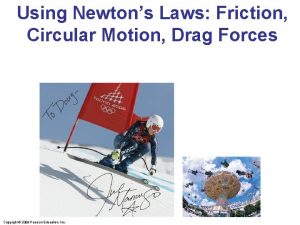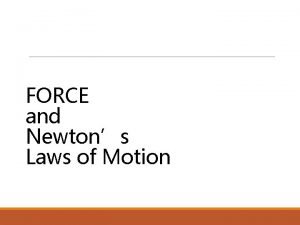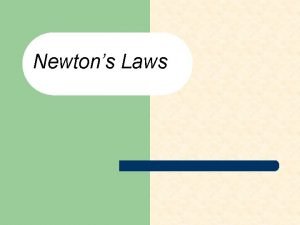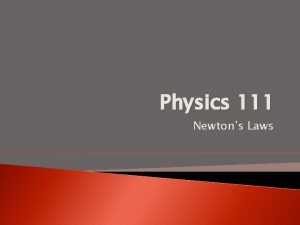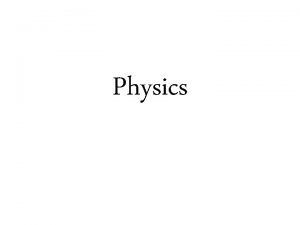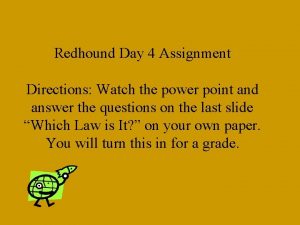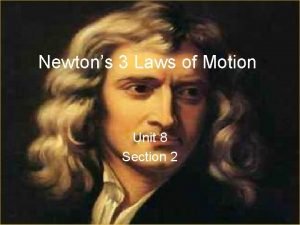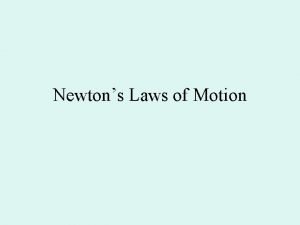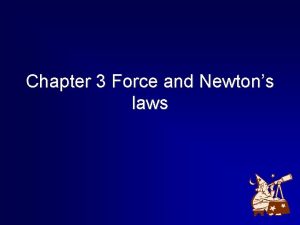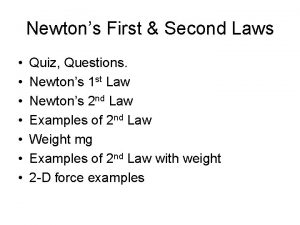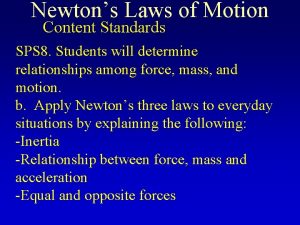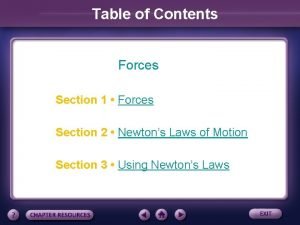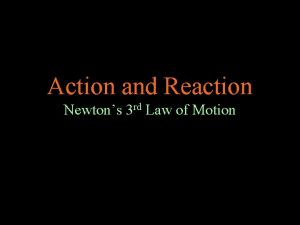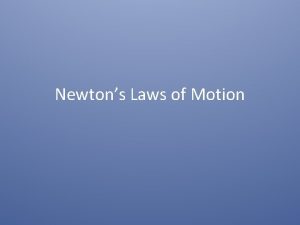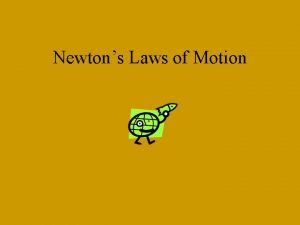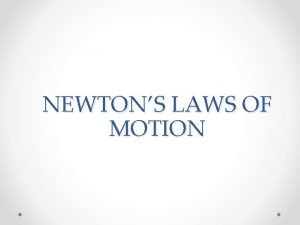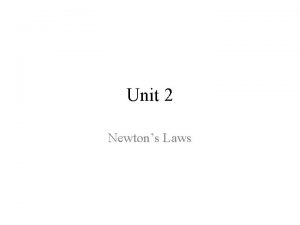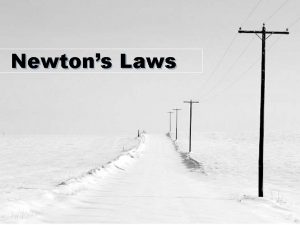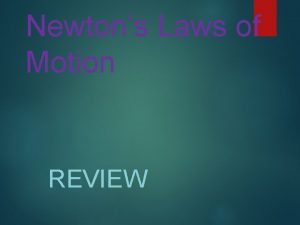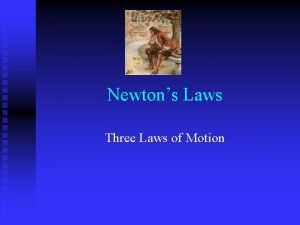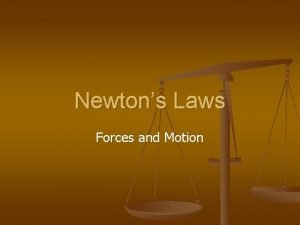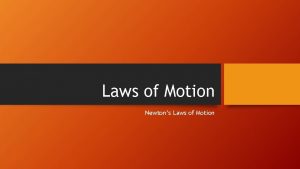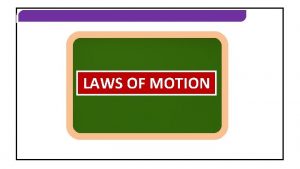Newtons 3 Laws of Motion Newtons 3 Laws







![Check Your Understanding • You exert a force of 45 N [up] on your Check Your Understanding • You exert a force of 45 N [up] on your](https://slidetodoc.com/presentation_image_h2/87ded43339bc8302cc81d04d8cd05a6d/image-8.jpg)






![Check Your Understanding • A net force of 58 N [W] is applied to Check Your Understanding • A net force of 58 N [W] is applied to](https://slidetodoc.com/presentation_image_h2/87ded43339bc8302cc81d04d8cd05a6d/image-15.jpg)








- Slides: 23

Newton’s 3 Laws of Motion • Newton’s 3 Laws Summary • Newton’s First Law • Applications • Newton’s Second Law • Second Law Simulation • Newton’s Third Law • Applications • Many opportunities for students to check their understanding

Newton’s Laws of Motion 1. a. k. a. The Law of Inertia: If the net force acting on an object is zero, that object maintains its state of rest or constant velocity. 2. An object accelerates in the direction of the net force. The acceleration is directly proportional to the net force and inversely proportional to the object’s mass. 3. For every action force, there is a simultaneous reaction force equal in magnitude but opposite in direction. Newton’s (N) as a unit of Force N = kg m/s 2

Newton’s First Law of Motion • a. k. a. The Law of Inertia: Things want to keep doing what they are doing. – Stationary objects don’t want to move – Moving objects don’t want to stop moving • To cause acceleration—the net force acting on an object cannot be zero.

Newton’s First Law of Motion This law has several important implications. • An external force is required to change the velocity of an object. • For an object to change velocity (including changing from v = 0), the Fnet must be greater zero in one direction. • Objects at rest remain at rest unless acted upon by an external Fnet greater zero. • Moving objects continue to move in a straight line at a constant speed unless acted upon by a net external force.


When net force is zero…

Application • An example occurs when a car slows down quickly; the people in the car tend to continue moving forward, possibly crashing their heads into the windshield if they are not wearing a seat belt. The seat belt prevents them from shooting forward through the windshield • An airbag acts in a similar fashion to stop the person from hitting their head on the dashboard or steering wheel during a front-end collision. • Both act to reduce the inertia experience by the passengers.
![Check Your Understanding You exert a force of 45 N up on your Check Your Understanding • You exert a force of 45 N [up] on your](https://slidetodoc.com/presentation_image_h2/87ded43339bc8302cc81d04d8cd05a6d/image-8.jpg)
Check Your Understanding • You exert a force of 45 N [up] on your backpack, causing it to move upward with a constant velocity. Determine the force of gravity on the pack. Answer: Fg = 45 N [down]

Check Your Understanding Solutions • The FBD of the pack (right) shows that two forces act on the pack: the applied force (Fapp) that you exert and the force of gravity (Fg) that Earth exerts. Since the pack is moving at a constant velocity, the net force must, by the law of inertia, be zero. So the upward and downward forces have the same magnitude, and Fg = 45 N [down].

Check Your Understanding • The traction system below stabilizes a broken tibia. Determine the force of the tibia on the pulley. Neglect friction. • Hint: A traction system is meant to create a Fnet = 0 so that the leg doesn’t move. Answer: Ftibia = 26 N [left 13° down]

Newton’s Second Law of Motion • An object accelerates in the direction of the net force. The acceleration is directly proportional to the net force and inversely proportional to the object’s mass. • F = ma a = F m • Acceleration increase as F increases • Acceleration decreases as m increases

Newton’s Second Law Demonstration • Record the accelerations for the 50, 100 and 200 kg objects using a force of 1000 N. • Perform the calculations yourself using F = ma for each mass. • What can you conclude about how a changes as mass changes? What kind of relationship exists?

Check Your Understanding • The mass of a hot-air balloon, including the passengers, is 9. 0 x 102 kg. The density of the air inside the balloon is adjusted by adjusting the heat output of the burner to give a buoyant force on the balloon of 9. 9 x 103 N [up]. Determine the vertical acceleration of the balloon.

Check Your Understanding Solution • Fnet = Fapp – Fg = 9900 N – 8820 N = 1080 N • a = Fnet/m = 1080 N / 900 kg = 1. 2 m/s 2 [up]
![Check Your Understanding A net force of 58 N W is applied to Check Your Understanding • A net force of 58 N [W] is applied to](https://slidetodoc.com/presentation_image_h2/87ded43339bc8302cc81d04d8cd05a6d/image-15.jpg)
Check Your Understanding • A net force of 58 N [W] is applied to a water polo ball of mass 0. 45 kg. Calculate the ball’s acceleration. Answer: 1. 3 × 102 m/s 2 [W]

Check Your Understanding • In an extreme test of its braking system under ideal road conditions, a Toyota Celica, travelling initially at 26. 9 m/s [S], comes to a stop in 2. 61 s. The mass of the car with the driver is 1. 18 × 103 kg. Calculate a) the car’s acceleration. b) the net force required to cause that acceleration. Answer: a) 10. 3 m/s 2 [N] b) 1. 22 × 104 N [N]

Newton’s Third Law of Motion • For every action force, there is a simultaneous reaction force equal in magnitude but opposite in direction. • For every action, there is an equal and opposite reaction • When a balloon is inflated and released, air rushing from the open nozzle causes the balloon to fly off in the opposite direction

Application • As the rocket pushes the fuel out the back, the fuel pushes back on the rocket to move the rocket forward • This even occurs in space where there isn’t any air to push against

Newton’s 3 rd Law

Check Your Understanding A contractor is pushing a stove across a kitchen floor with a constant velocity of 18 cm/s [fwd]. The contractor is exerting a constant horizontal force of 85 N [fwd]. The force of gravity on the stove is 447 N [down]. a) Determine the normal force (FN ) and the force of friction (Ff ) acting on the stove. b) Determine the total force applied by the floor (Ffloor) on the stove. Answer: a) FN = 447 N [up] Ff = 85 N [backwards] b) Ffloor = 455 N [fwd 79° up]

Check Your Understanding Sleds A and B are connected by a horizontal rope, with A in front of B. Sled A is pulled forward by means of a horizontal rope with a tension of magnitude 29. 0 N. The masses of A and B are 6. 7 kg and 5. 6 kg, respectively. The magnitudes of friction on A and B are 9. 0 N and 8. 0 N, respectively. Calculate the magnitude of the acceleration of the two-sled system. Answer: a = 0. 98 m/s 2

Check Your Understanding At an indoor skating rink children skate with their parents. Behind each child, a parent, also on skates, prepares to push horizontally to see who can push their child the farthest. In this competition, a certain mother has a mass of 61 kg, and her daughter a mass of 19 kg. Both skaters experience negligible. At the starting bell, the mother pushes the child with a constant applied force of magnitude 56 N for 0. 83 s. Determine the magnitude of a) the daughter’s acceleration. b) the mother’s acceleration. c) the maximum velocity of the daughter. Answers: a) ad = 2. 9 m/s 2 b) am = is 0. 92 m/s 2 c) Vf daughter = 2. 4 m/s

Let’s Summarize
 The three laws of motion
The three laws of motion Law of motion 3
Law of motion 3 Colin skateboards down the sidewalk
Colin skateboards down the sidewalk What are newtons 3 laws
What are newtons 3 laws Law of friction
Law of friction Newtons laws definitions
Newtons laws definitions Newtons 3 laws
Newtons 3 laws Newtons laws
Newtons laws Section 3 using newtons laws
Section 3 using newtons laws Ethan is dragging a bag of grass
Ethan is dragging a bag of grass Newton laws
Newton laws Newtons 3 laws
Newtons 3 laws Newtons laws of gravity
Newtons laws of gravity Newton's 3 law of motion
Newton's 3 law of motion First law of motion facts
First law of motion facts Facts about newtons first law
Facts about newtons first law Newton's 3rd law
Newton's 3rd law Section 3 using newtons law
Section 3 using newtons law Law of inertia
Law of inertia Newtons 3 laws quiz
Newtons 3 laws quiz Universal gravitation law
Universal gravitation law Examples of law of inertia
Examples of law of inertia Section 3 using newtons laws
Section 3 using newtons laws Newtons 3 rd law of motion
Newtons 3 rd law of motion




